The COVID-19 crisis has us all struggling to find a proper work-life balance as we work remotely (some of us for the first time) for an indefinite period.
As managers, the morale of your remote workforce takes priority in the current climate of stress and uncertainty.
When people who have so far been accustomed to face-to-face interactions are expected to communicate solely over voice and audio calls, unresolved issues can quickly escalate.
Non-verbal cues that signal a person’s intentions and opinions can be easily missed in a virtual environment.
You can minimize negative feelings and confusion by incorporating a regular exchange of feedback into your one on one meetings and conversations.
Read on to find some real-life examples of constructive criticism to help you initiate what is bound to be an uncomfortable conversation with your direct report.
What is constructive criticism?
Constructive criticism is distinct from negative criticism.
It is feedback offered with the intention of improvement, thus including specific suggestions for positive change.
Constructive criticism is most effective when it is timely, actionable, specific, and clear.
Why is constructive criticism necessary?
Constructive criticism is necessary to manage workflow and ensure employee growth and satisfaction.
But, your direct report may feel personally attacked if you frame and deliver your feedback incorrectly.
That’s not what you want!
When feedback is delivered with empathy and patience, your direct reports will respond positively.
In fact, research shows that employees do understand the importance of constructive criticism–and even prefer it to praise and congratulatory comments.
Constructive criticism vs. Destructive criticism
Constructive criticism and Destructive criticism differ in their intentions, delivery, and outcomes. While both types of criticism may highlight an issue or a problem, the approaches taken and the end goals are vastly different.
Constructive criticism aims to promote growth and development. It is delivered with care and respect, focusing on specific behaviors or actions that need improvement. The primary goal of constructive criticism is to help individuals realize their potential, empowering them to make the necessary changes for better performance and personal growth.
Destructive criticism, on the other hand, is intended to belittle, demoralize, or undermine an individual. It often lacks specificity and focuses on the person rather than their behavior. Destructive criticism is frequently vague, poorly timed, and accompanied by negative emotions. It can lead to feelings of inadequacy, decreased motivation, and even resentment in the recipient.
Obnoxious Aggression vs. Ruinous Empathy
Kim Scott, author of Radical Candor, said something similar:
Employees prefer obnoxious aggression to ruinous empathy.
Her simple, yet powerful tool to build effective employee relationships is called ‘radical candor,’ which has two dimensions:
- Caring personally
- Challenging directly
She developed the following quadrant based on her experiences at the workplace:
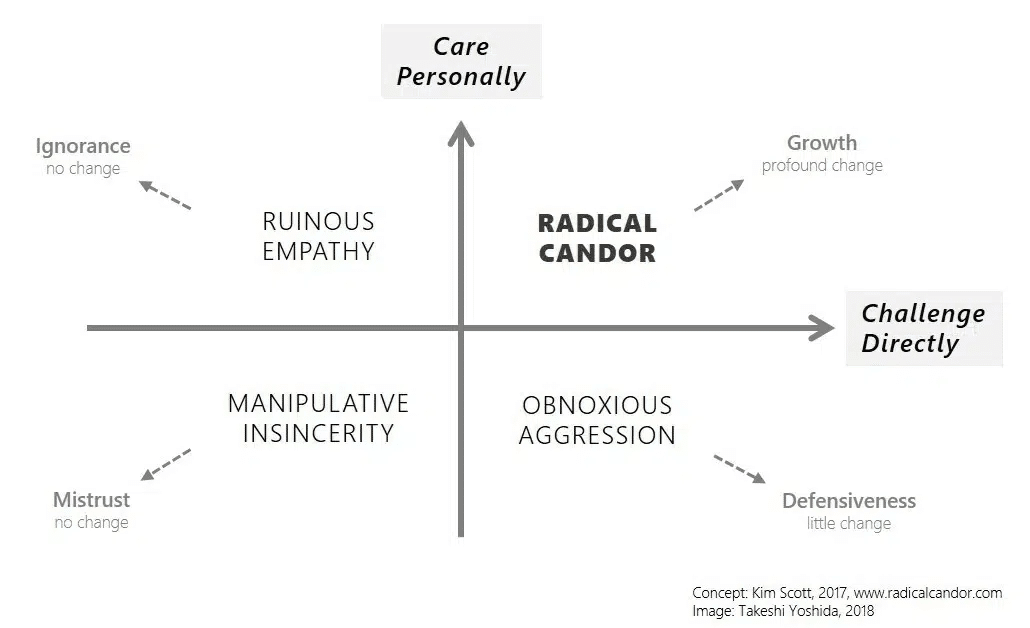
Obnoxious aggression and ruinous empathy are both unhelpful for your direct reports.
- When you criticize somebody with little or no indication that you care, you’re being obnoxiously aggressive.
- Ruinous empathy is the opposite–you care for the person, but you’re scared to provide direct criticism.
If you continue to speak and behave as if nothing is wrong just because you want to spare your direct report’s feelings, nothing is going to change.
In short, it’s not about what we’re saying, it’s about how we’re saying it.
Are you following F.A.S.T?
You can deliver constructive criticism in a variety of ways, each suitable for a given situation or direct report, but all these methods should follow the principle of F.A.S.T.
F = Frequency
A = Accuracy
S = Specificity
T = Timeliness

Frequency:
Not all your direct reports will be alike, so you cannot apply the same management style to everyone. Find out how often each person needs feedback and connect individually as required.
Accuracy:
Trust is the glue that holds teams together, especially those working remotely. Before you offer constructive criticism, take care to ensure that your facts are correct.
Specificity:
You’ll want your advice to be taken seriously and have an impact. Skip the generalizations and quote specific examples.
Follow up with an offer of support to show that you’re invested in the progress of your direct report.
Timeliness:
Perhaps the most important factor of all, sharing constructive criticism as promptly as possible will help you minimize friction and negative feelings.
You don’t want to delay feedback, however harsh, because your direct report will continue with the undesirable behavior and you’ll be frustrated with his poor outcomes.
Guide to Giving Constructive Feedback
Master the Art of Giving Constructive Feedback to your Remote Teams.
Guide to Giving Constructive Feedback
Master the Art of Giving Constructive Feedback to your Remote Teams.
Effective One on One Meetings
We built a software that automatically schedules, lets you set agenda, take notes, exchange feedback and track actions – all in one place.
7 tried-and-tested Methods and Examples of Constructive Criticism
We have explored some of the most popular methods managers use, along with examples of constructive criticism.
Not all of these can be used regularly, and some are more effective than others in certain situations.
1 The 3×3 Method
(Proposed by Bert Decker in his book ‘You’ve Got To Be Believed To Be Heard.’)

When to use:
When you need a method to offer (and solicit) continuous feedback from your direct reports, the 3×3 method is most effective.
According to Decker,
Receiving three bits of feedback at a time allows people to make course corrections, like a guided missile, as they keep moving onward and upward.
It involves sharing three strengths and three areas of potential development. Remember, authenticity is key.
You’ll want to keep the feedback succinct and limit the number of items you talk about during one meeting to avoid overwhelming your direct report.
By offering constructive criticism in this way, employees view the feedback as a challenge to improve instead of a strategy to quash their ego.
Real-life example:
Suppose you’re a manager and your direct report has just concluded giving a presentation. You need to help her work on her weaknesses while ensuring she doesn’t think she’s a failure.
You won’t be helping her by saying this:
“The content was fine but you need to put more emotion into your speech. Didn’t you see the audience was getting bored?
And why did you generalize so much in your responses during the Q&A session? It didn’t help your listeners at all.”
Instead, you could use the 3X3 method and talk to her like this:
“The presentation was very well put together. However, it could have been more impactful with a more emotional delivery.
The introduction and closing were especially strong, but a conversational tone would have engaged the audience better.
It was interesting to see how you quoted from a wide variety of sources, but more specific examples in the Q&A session would have been good.”
2 The 5 Word Review Method
(Created by Paul English, CEO of Kayak.com)

When to use:
When you want to offer high-level feedback to your direct reports as you observe trends in their performance and behavior, the 5 Word Review method can get your message across in a non-threatening, relaxed, and friendly manner.
It is a great way to build and strengthen your working relationship with your direct report.
Here’s how it works:
1 Note down 5 words to describe your direct report. (2-3 positive, 2-3 negative)
2 Meet in an informal setting, such as a cafe or over lunch (a one on one meeting would be great!) and look over these words with your direct report. (~1 hour)
3 Discuss each word in detail to understand it fully and generate several perspectives.
Remember not to rush through the positive words to focus on the negative ones.
The positive words should describe what you like about your direct report and what they should continue doing.
Give yourself an hour to discuss the meaning behind each word and ensure that your direct report understands them fully.
The simplicity of the method makes it useful to give feedback at any time in the year. It highlights overarching trends like what your direct report consistently does right or wrong.
Since it feels more like a friendly chat than a harsh feedback session, your direct report is less likely to be defensive and more likely to make good use of your guidance.
Real-life example:
Let’s say one of your direct reports works well as an individual contributor, but less so as a team player. However, the project he is involved in requires him to collaborate with others.
You could give him the following words:
- Quick
- Technical
- Controlling
- Conservative
- Organized
During the discussion, you can praise his timeliness and his ability to grasp the nuances of a project quickly.
You can appreciate the strength of his technical knowledge.
Next, you can discuss how he’s possessive of his work and unwilling to take risks or think out of the box–which is harming the outcomes of the project he’s working on. Talk about how he can try to be more trusting of his teammates and rely on them to contribute useful ideas.
Lastly, you can say that his organizational skills are helping his team members work smoothly on the project.
3 The Situation, Behavior, Impact (SBI) Method
(Developed by The Center for Creative Leadership)
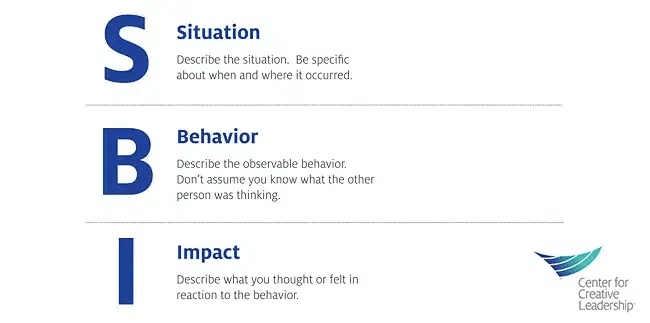
When to use:
This method of giving constructive criticism is most useful when a situation has come up suddenly and you’re required to offer feedback immediately.
It helps you manage difficult, unexpected situations, and communicate negative messages in a delicate manner.
The steps are:
1 Explain the situation.
2 Highlight the specific behavior you’re addressing.
3 Describe how this behavior affects you, the team, or the business.
Remember to use “I” statements and keep judgments out of your feedback to prevent undermining your message.
The SBI model helps direct reports understand the impact of their behavior on other people. It gives them a chance to understand your concerns without feeling like a chastised child.
Some other similar models, which are also widely used, are:
1 BEEF (Behavior, Example, Effect, Future)
2 AID (Action, Impact, Development, Desired Behavior)
3 BIFF (Behavior, Impact, Future, Feelings) — adds an additional step at the end to gauge how the individual feels after receiving the feedback
Real-life example:
Imagine you have a direct report, Susan, who is consistently coming late to work.
You don’t want to attack her like this:
“Susan, you’re coming in late every day. If this continues, we’ll have to dock your pay.”
Instead, use the SBI model to say something like this:
“Susan, I want to talk to you about logging in late every day.
When you’re late for your shift, we have to hold someone over from the previous shift.
This requires us to pay that person over time, it causes your co-worker inconvenience, and it may also affect the quality of work if she doesn’t fully understand your job. Do you understand?”
4 Pendleton’s Feedback Model
(Developed by Pendleton in 1984)
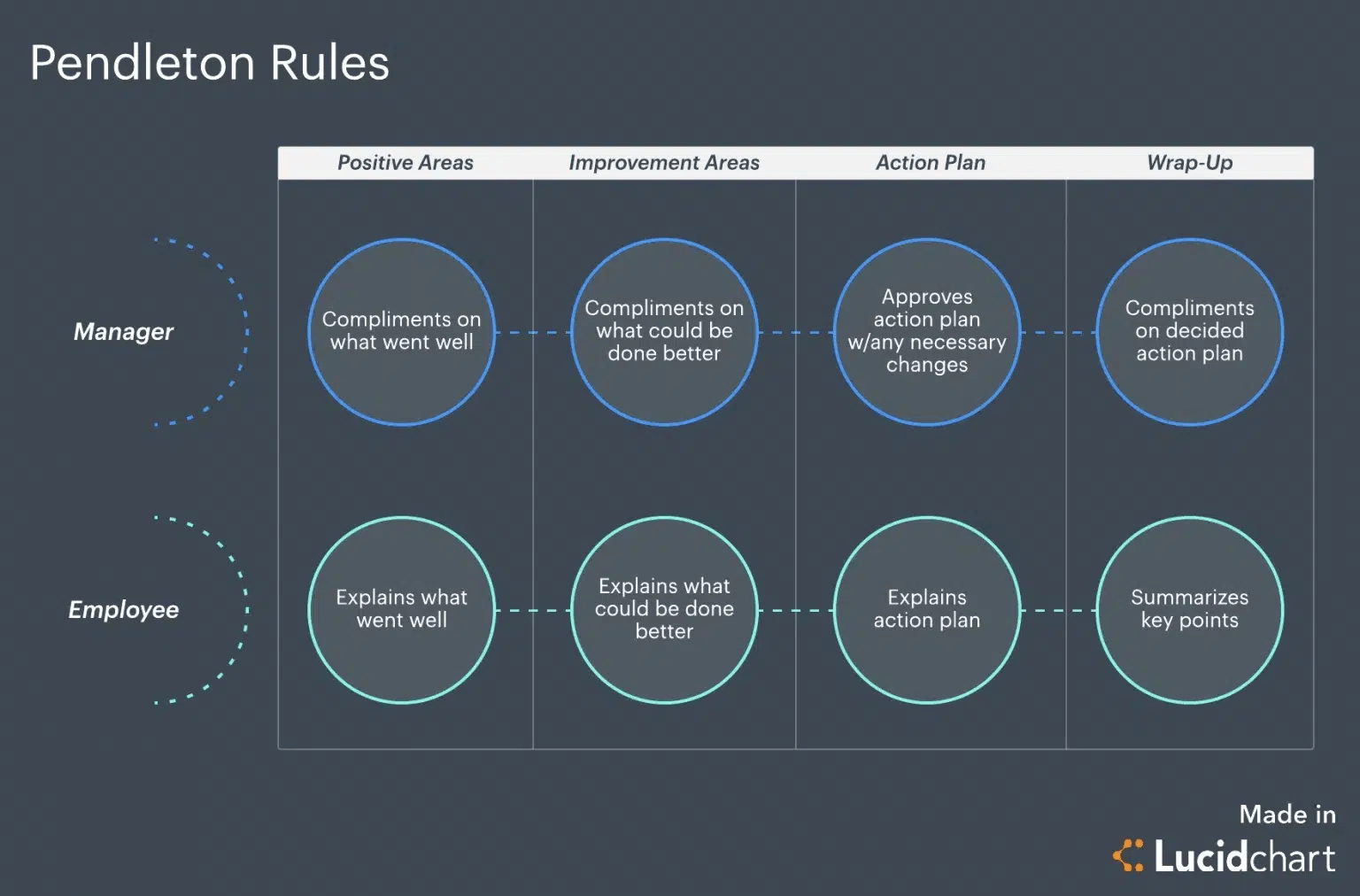
This method of giving constructive criticism has most often been used in the medical industry.
Some tech companies like Lucidchart, a web-based proprietary platform that allows users to collaborate on drawing, revising, and sharing charts and diagrams, have successfully employed it as well.
When to use:
When you’re looking to involve your direct report in the feedback and give him a chance at self-reflection, Pendleton’s feedback model is the best.
This method helps you set a positive tone for the feedback session right from the start. The guided self-reflection helps your direct report meet his professional goals successfully.
You can follow these steps:
1 Encourage your direct report to describe what he thinks is going well.
2 Talk about positive interactions and discuss the factors that lead to good results.
3 Describe the areas of improvement and explain what your direct report could have done differently.
Real-life example:
An example of constructive criticism using Pendleton’s feedback model is:
Manager: So David, how do you think things are shaping up with your current project?
Direct report: It has been good so far; just that initially the guidelines were not clear so there was a bit of confusion about which approach we should take.
Manager: Right, now that that has been taken care of, I can see things are going really well. Our client was really happy with the quality of our first submission.
Direct report: I’m glad, and I hope to continue delivering satisfactory quality. My editor has been super helpful with suggesting ways I can make my document better.
Manager: That brings me to a topic I wanted to discuss. Perhaps it would be good if you could block off some time on both your calendars to discuss changes to your document instead of dropping in by her desk every half an hour with queries. Not everybody likes to be interrupted frequently because it prevents them from concentrating on their work.
Direct report: I didn’t realize that. I’ll do so going forward.
5 The Stop, Start, Continue Method
(Developed by Phil Daniels)

When to use:
When you need to coach new team members and familiarize them with the organizational culture, the Stop, Start, Continue method is quite helpful.
This is how you can go about it:
1 Discuss things that do not work and the direct report should STOP doing
2 Shift focus to new things the DR should try out instead, stating what she should START doing
3 End the session by pointing out things the DR is doing right and should CONTINUE doing
The stop, start, continue method is a neat and organized approach to offering constructive criticism.
Real-life example:
Let’s say you have a new direct report who is great at his
work but tends to get angry and confrontational during discussions.
You could say something like this:
“When you raise your voice during our meetings whenever somebody contradicts you, you make your team members uncomfortable. This is something you need to be aware of and not do in the future.
What you could do instead is practice flexibility with your ideas. You could discover new approaches by listening to the opinions of others.
In fact, you excel at creating eye-catching presentations with innovative ideas, and I would love to continue seeing that from you.”
6 The STAR – Situation, Task, Action, Result – Method
(Developed by Development Dimensions International Inc.)
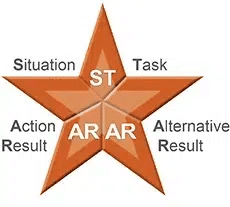
When to use:
When you want to give feedback on certain specific actions of your direct report, the STAR feedback model is effective.
This model breaks feedback into 4 categories:
1 Situation/Task: You explain the specific situation or task your direct report was involved in.
2 Action: You describe the action taken by the direct report, including details of what was said and done. The action can be negative or positive.
3 Result: You outline the result of the action taken so that your direct report understands what he did right or wrong.
If your direct report took a negative action, you should talk about an alternative action and its consequences to show what could have been done and how it would have been more effective.
Real-life example:
Let’s say Sarah, one of your direct reports, has a habit of procrastinating and tends to complete her work too close to the deadline. You want to talk about time management with her.
You could go about it like this:
“Sarah, we almost missed our project submission deadline.
I saw you coming in early and staying back late to finish the work just before the end date.
While it’s good that you’re dedicated enough to ensure that you don’t miss the deadline, your delay caused your team members to work overtime, too.
This causes them a lot of inconveniences. Do you understand?”
Guide to Giving Constructive Feedback
Master the Art of Giving Constructive Feedback to your Remote Teams.
Guide to Giving Constructive Feedback
Master the Art of Giving Constructive Feedback to your Remote Teams.
Effective One on One Meetings
We built a software that automatically schedules, lets you set agenda, take notes, exchange feedback and track actions – all in one place.
Guide to Giving Constructive Feedback
7 The DESC – Describe, Express, Specify, Consequences – Model
(Developed by Sharon and Gordon Bower, authors of Asserting Yourself)
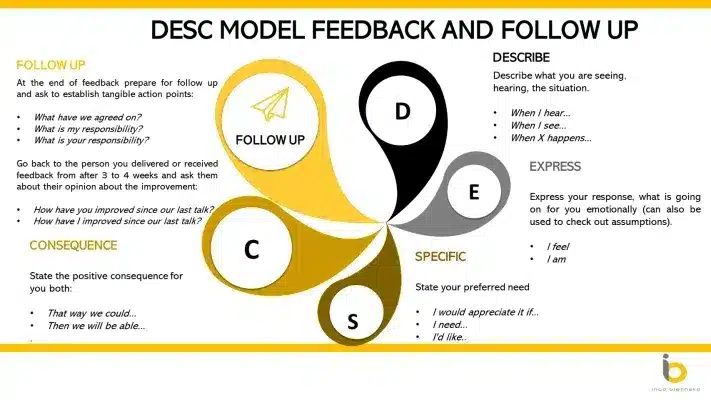
When to use:
Use the DESC feedback model when you’re stressed about giving constructive criticism to your direct report and you need a structured method to make your method clear.
The steps involved are:
1 Describe: your direct report’s behavior clearly using “I” statements.
2 Express: the impact the behavior had on you, the team, or the company.
3 Specify: what you’d like your direct report to do the next time around.
You can use a directive tone (Next time, when something like this happens, I would like to see….) or a participative tone (How do you think we can avoid something like this in the future?)
Ask your direct report if he agrees to what you’ve said.
4 Consequences: You can make the consequences of the desired behavioral change clear.
Of course, it helps to prepare what you’re going to say beforehand so that no important details are missed.
Real-life example:
Let’s take the example again of a direct report turning up late consistently. A good way to discuss the issue would be:
“Terence, I want to talk to you about your late coming, especially the fact that you have come an hour late three times this week.
When you regularly come in late, it makes the whole team look unprofessional. Also, it sets a bad example for our new team members.
I’d like to see you make an effort to come into work on time every day unless there’s a pressing issue.
You’ll also be able to attend the daily stand-ups if you step in at 9 every day. I hope you understand.”
Pro Tip: Don’t use the Feedback Sandwich method (positive – negative – positive) because it gets predictable and your positive comments lose value if your direct report perceives them to be dishonest.
Employees may even begin to associate positive comments with negative feedback. And you don’t want that!
Use one on one meetings to give constructive criticism
One on one meetings are a powerful way to offer constructive criticism because it is a face to face conversation instead of a written message.
It is also a recurring event in your calendar, a private and psychologically safe space where you and your direct report can talk about things you normally wouldn’t say in a group meeting.
You don’t need to schedule a special meeting to give feedback; since feedback can be a part of the one on one meeting agenda.
The regularity of one on one meetings ensures that you are offering constructive criticism in a timely manner, although not in the heat of the moment (which could be damaging).
Receiving Constructive criticism
Till now we have only talked about how to give constructive criticism, but how do you receive it? It’s hard to accept that someone has pointed out something wrong with your work, especially if the person giving feedback is in a position of authority over you.
It’s human nature to feel a little defensive, especially if you’ve put a lot of work into something. So, how do you take criticism without letting it get under your skin?
Here are some things to keep in mind:
- Embrace the opportunity to learn: Understand that receiving constructive criticism is an opportunity to grow and improve your skills. Remind yourself that nobody is perfect, and we all have areas where we can improve. When someone offers feedback, view it as a chance to learn from their perspective and experience.
- Focus on comprehension, not rebuttal: As you listen to the constructive criticism being offered, concentrate on understanding the message rather than preparing a response or defending yourself. Keep in mind that the person is sharing their insights to support your development, so approach the conversation with an open mind.
- Ask for clarification without disputing the feedback: While it’s not appropriate to contest or deny the feedback, it’s perfectly acceptable to inquire for more information or to brainstorm ways to enhance your performance. If you’re not prepared to ask questions immediately following the feedback session, that’s alright. Schedule a follow-up meeting to discuss strategies for improvement further.
- Evaluate the feedback objectively: After receiving the criticism, take some time to objectively evaluate it. Consider the validity of the points raised, and determine if they can help you improve. If the feedback is valid, create a plan to address the areas where you can improve. If it’s not, simply let it go.
- Separate the feedback from your self-worth: Remember that constructive criticism is about your work or performance, not about you as a person. Don’t take it personally or let it define your self-worth. Focus on the specific areas that need improvement rather than dwelling on negative feelings.
Conclusion
We hope these examples of constructive criticism will help you speak candidly with your direct reports.
You must take your time choosing the method that best works for you and your direct report.
You can pick a method that suits you best or combine a few methods to arrive at your own unique strategy.
Constructive criticism is a normal and essential part of work.
Make your direct reports look forward to it, if not love it.








